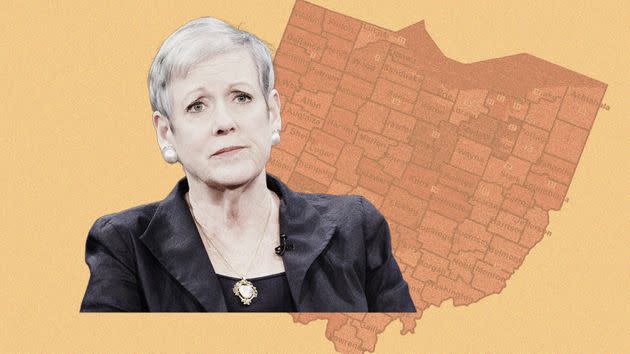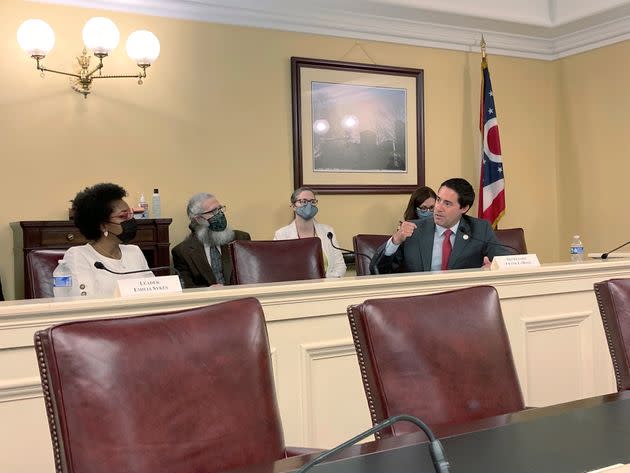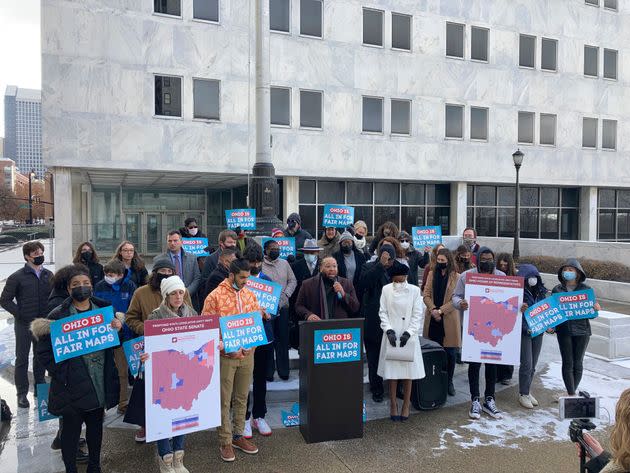She Was The Most Powerful Woman In Ohio. But There Was One Big Problem She Couldn’t Fix.

Maureen O'Connor, a Republican retired chief justice of the Ohio Supreme Court, sided with her Democratic colleagues to find that the Ohio Redistricting Commission's maps were unconstitutionally unfair to Democrats.
Maureen O’Connor was the most powerful woman in Ohio politics for the better part of 24 years, first as lieutenant governor and later as the chief justice of the Ohio Supreme Court. But when I asked if her state currently has a legitimately representative government, she didn’t answer right away.
That’s because it’s an open question.
For one thing, the Ohio state House and Senate and the state’s congressional delegation were elected in 2022 using maps that a majority of the Ohio Supreme Court, including O’Connor, ruled were unconstitutionally unfair to Democrats. The maps, drafted by the Ohio Redistricting Commission — composed of Gov. Mike DeWine (R), Ohio Secretary of State Frank LaRose (R), Auditor Keith Faber (R), and two members of each party from the state legislature — disproportionately favored Republican candidates, in violation of constitutional amendments that were approved by a wide margin of voters just a few years earlier, the court found.
Unlike other states such as New York, Ohio’s anti-gerrymandering language, written by the legislature, does not give the state Supreme Court authority to hire independent mapmakers on its own. The court may only reject maps it deems unconstitutional. With no legal backstop, the Republican-dominated redistricting commission had no incentive to come up with maps the court would approve, and it didn’t.
The state maps were found to be unconstitutional a total of five times between January and May last year. In response to each of the court’s rulings, Republicans on the redistricting commission repeatedly doubled down. Defying the court, they created a constitutional crisis and delayed the redistricting process so badly that a federal panel stepped in at the request of local anti-abortion activists and allowed the unconstitutional maps to be used.
Amid the monthslong battle, some Republicans indicated they might support impeaching O’Connor, who as a Republican was vilified for breaking ranks with her party. A state age limit has since forced O’Connor to retire, and the Ohio Supreme Court now has a solid Republican majority — meaning the gerrymandered maps are likely here to stay.

Then-Chief Justice Maureen O'Connor serves as a guest panelist for the Courting Justice With Tavis Smiley forum on Dec. 8, 2016, in Cleveland.
Out of office, O’Connor hasn’t lost sight of the fight for fair districts. She says she’ll work to build support for a constitutional amendment in the state to create an independent redistricting process and “get the politicians, the elected officials, off the redistricting commission.”
But for now, the product of the GOP-drawn maps is clear: It’s a stacked deck.
Republican candidates collectively won 57% of the state Senate votes overall in 2022 and yet control 79% of the state Senate seats, according to a HuffPost analysis of election results. Republican candidates won 59% of the state House votes and control 68% of the state House seats. GOP congressional candidates collectively won 57% of the vote against Democrats, and yet control 67% of the state’s congressional seats.
So is Ohio a representative democracy in any real sense? O’Connor sighed when asked that exact question.
“That’s the whole problem with gerrymandering ... Who’s being represented? And how did they secure that representation?” she said. The real question, O’Connor added, “is not how the voters secure that representation, but how the politicians secure the voters.”
‘No Apology’
From the start, O’Connor knew the Republicans tasked with drawing districts would be trouble.
When the redistricting commission submitted its first set of legislative maps in September 2021, it justified a laughably lopsided Republican advantage by explaining that GOP candidates had won 13 times in the last 16 statewide elections — meaning, according to the GOP logic, that the “statewide proportion of voters favoring statewide Republican candidates” was 81%.
The New York Times called the argument “statistical sleight of hand,” and critics noted that under that reasoning, extremely liberal states would be justified in making all of their districts Democrat-leaning, even if regional political preferences broke from statewide trends.
The Ohio Supreme Court found that the maps plainly violated constitutional language forbidding districts that unduly favored one party — language that voters had overwhelmingly supported just a few years prior.
O’Connor was furious.
“There was no apology for that by the map-drawers for the party that’s in power … It’s almost [a] to-the-victor-go-the-spoils type of mentality. That’s not representative government,” she told HuffPost. “That’s a dictatorship, that’s not a constitution.”
That’s the whole problem with gerrymandering... Who’s being represented? And how did they secure that representation?Maureen O'Connor, former chief justice, Ohio Supreme Court
O’Connor and three Democratic justices ruled against the commission, voiding the proposed maps and sending the commission back to the drawing board.
In a concurrence, O’Connor said the commission was “seemingly unwilling to put aside partisan concerns as directed by the people’s vote.” She spent several pages discussing other states that had created independent redistricting commissions, noting that they were potential models for Ohioans.
Voters, she wrote, should understand “they have the power to again amend the Ohio Constitution to ensure that partisan politics is removed from the drawing of Ohio Senate and House districts that takes place every ten years.”
Even the redistricting commission’s Republicans seemed to know they’d gone too far. In a private message to his chief of staff that was later revealed as part of litigation, LaRose, the secretary of state, called the 81% rationale “asinine.” (“One of the only genuine utterances to come from him,” O’Connor observed.) “I should vote no,” LaRose wrote privately, just before voting “yes” on the maps.
Upon the commission’s vote, DeWine, who also voted in support of the lopsided Republican advantage, acknowledged that the commission “could have produced a more clearly constitutional bill.”
“More constitutional,” O’Connor scoffed 16 months later. “Either it’s constitutional or it’s not. It’s like ‘a little bit pregnant.’”

Ohio Elections Chief Frank LaRose, right, speaks during a meeting of the Ohio Redistricting Commission, Aug. 31, 2021, in Columbus, Ohio, as Rep. Emilia Sykes, of Akron, listens.
A Little Bit Pregnant
Things did not get better from there. The redistricting commission Republicans’ next maps nominally included more Democratic-leaning districts — but upon closer inspection, they were essentially even toss-ups, especially compared to the solidly red GOP districts.
“That just masquerades as compliance with the constitution,” O’Connor said of the toss-up districts that were labeled Democratic-leaning. Ultimately, Republicans dominated these districts in November, as expected, contributing to the growth of their supermajorities in the state legislature.
Eventually, after yet another set of maps that the state Supreme Court majority ruled were clearly drawn to “favor the Republican Party & disfavor the Democratic Party,” the majority urged the redistricting commission to hire independent mapmakers to draw the next maps. And the commission complied, streaming the process online, until the last minute.
With hours to go before the deadline to submit new maps, and with two independent mapmakers nearly finished with their assignment, the Republican commissioners stepped in, opting instead for a pre-drawn draft from Republican staffers — what was really only a slight alteration of previously rejected maps.
Dan Tierney, DeWine’s press secretary, recounted what happened from the governor’s perspective to HuffPost: One of the two independent mapmakers had indicated that in order to meet the Ohio Constitution’s language about proportionality, “every time we have to make a decision, we have to benefit the Democratic Party.” Republicans on the commission, Tierney said, wouldn’t support such a proposal — what he called “likely a Democratic gerrymander.” So it was a matter of either asking the court for a little more time to finish the independent maps, or just submitting a slightly tweaked version of districts the court had already found unconstitutional. Republicans chose the latter option. What had been a glimmer of hope for professional, fair maps was gone.
“It wasn’t even sleight of hand,” O’Connor said. “With sleight of hand, you’re left scratching your head about what happened there. That wasn’t even it. It was blatant. It was brazen. It was just the president of the Senate pulling out a map and saying, ‘Gee, we’re out of time. We’ve got this map. It’s been drawn, we had it in our back pocket. This is what we’re going to do.’”
Eventually, Republican politicians in the state grew frustrated with their chief justice’s intransigence. In a caucus phone call reported by the Ohio Capital Journal, multiple legislators voiced support for impeaching O’Connor. LaRose said he would be “fine” with O’Connor being booted from the court.
O’Connor told HuffPost the impeachment chatter was “of course a threat.” In one interview with The Associated Press, she even invoked Germany under Adolf Hitler, telling Republicans to review their history. She told HuffPost, “I was talking about the legal maneuvering that Hitler used in order to get a toehold in the very beginning of his ascent to power in Germany.”
It was blatant. It was brazen. It was just the president of the Senate pulling out a map and saying, ‘Gee, we’re out of time. We’ve got this map. It’s been drawn, we had it in our back pocket. This is what we’re going to do.’O'Connor
Litigants in the redistricting fight and regular Ohioans have called for consequences for the Republicans repeatedly drawing unconstitutional maps and ignoring the court. And though the court considered contempt hearings for the commissioners, it never followed through. Commissioners argued they were simply acting as pseudo-legislators tasked with drafting a bill, and O’Connor shared separation of powers concerns: “It would have really ignited a constitutional crisis, and I don’t use that word lightly.”
Republicans on the commission have attempted to defend their maps. Rob Nichols, a spokesperson for LaRose, told HuffPost that O’Connor had gone outside the framework of the Ohio Constitution in her rulings — “less ‘what works under the requirements under the constitution’ and more ‘guess what new constitutional requirement Maureen O’Connor will make up next,’” he said in an email.
Redistricting Commission Co-Chair Vernon Sykes (D), a state senator who was one of two Democrats on the panel and one of the authors of Ohio’s current anti-gerrymandering constitutional language, disagreed, saying in a statement that the court correctly interpreted the law “but was ignored by the Republicans on the Ohio Redistricting Commission.”
“We do believe we made a good faith attempt to satisfy the court orders,” said Tierney, the governor’s spokesperson, adding that Republicans on the commission didn’t see a way to draw Democratic and Republican districts proportional to statewide preferences without violating other constitutional principles including the compactness of the districts. “We were just at a legal impasse because you could not change the laws of mathematics to comply with the court order.”

Anti-gerrymandering advocates rally outside the Ohio Supreme Court, Dec. 8, 2021, in Columbus, Ohio.
Taking The Fight To Federal Court
Though the Ohio Constitution’s weak enforcement mechanisms for its fair districting language provided an incentive for Republicans to break the rules, that was only half of the story: The other half was the looming presence of the federal court system.
As the redistricting fight dragged on, it began to threaten Ohio’s election schedule, and LaRose ultimately did separate the state House and Senate elections onto a separate ballot, forcing Ohio voters to participate twice in the primary process. While the legislature refused to consider pushing the primary dates farther back, anti-abortion activists meanwhile went to federal court, urging the use of a map the state Supreme Court had already rejected because, they said, the continued delays were threatening Ohioans’ voting rights.
The state Supreme Court’s majority saw the writing on the wall — two of the three federal judges on the case were appointed by Donald Trump— and attempted to stave off the federal intervention, which they called a “dubious proposition.”
“Principles of federalism and comity cut against a federal court ordering the date of a primary election for purely state offices due to a dispute over the validity of state legislative maps under the state constitution,” the majority on the state court wrote, saying Ohio was stuck in a “time loop” because of the power the redistricting commission had assumed for itself.
The federal court didn’t heed the state court’s request. In April, it set a May 28 deadline, by which time it would force the state to use the commission’s third set of maps — which the state Supreme Court had rejected as unconstitutional — unless the redistricting commission and state Supreme Court were able to “set aside their differences.”
The one dissent on the panel, Algenon Marbley, a Bill Clinton nominee and chief judge of the Southern District of Ohio, noted that Ohio was only in the “redistricting saga” because the redistricting commission’s Republicans had “manufactured a sufficient emergency” to provoke the federal court to intervene.
Republicans were thrilled. “Now I know it’s been a tough night for all you libs,” tweeted Bill Seitz, a high-ranking Republican in the state House. “Pour yourself a glass of warm milk and you will sleep better. The game is over and you lost.”
The redistricting commission, now freed from any pressure to comply with the law, simply voted to resubmit old maps in the intervening time as observers in the public meeting shouted for them to be held in contempt of court. On May 27, the federal court ordered Ohio to use the unconstitutional maps.
“That directive from the federal court, that was their shield, that is what the redistricting commission had in order to protect them, and it did protect them,” O’Connor said. “I disagreed with the ruling by that federal three-judge panel. I disagreed with their authority, and I disagreed with the result.”
Pour yourself a glass of warm milk and you will sleep better. The game is over and you lost.Ohio State Rep. Bill Seitz (R)
The incident was an ominous precursor to the right-wing embrace of an idea known as the “independent state legislature” theory, which asserts — despite a stunning lack of historical precedent — that the U.S. Constitution doesn’t allow state supreme courts to constrain state legislatures on issues related to federal elections, such as redistricting rules, and that legal disputes should be sorted out by federal judges. The U.S. Supreme Court heard arguments over the theory in December, and it may bless the idea, radically changing American election law.
Ohio Republicans are jumping on the bandwagon: In October, Ohio Senate President Matt Huffman and then-House Speaker Bob Cupp, two redistricting commission members who resigned from the panel after driving much of Republicans’ redistricting strategy last year, asked the U.S. Supreme Court to apply independent state legislature theory to the situation in Ohio.
“While many believe that the Ohio Supreme Court majority misinterpreted state law,” Huffman and Cupp wrote, “there is also the broader concern that the court assumed a role the federal constitution does not permit it to exercise. This is a matter that needs resolution by our nation’s highest court.”
The theory, O’Connor said, “makes no sense.”
“It throws the whole concept that is the bedrock of our government, of checks and balances, out the window,” she added. “We’ve got 50 independent states, and the independence of the states I think is punctuated by the fact that we have state supreme courts as well as executive branches and legislative branches.”
‘There Needs To Be An Amendment’
The situation with Ohio, with O’Connor off of the court, has changed. Sharon Kennedy, a Republican justice who’d sided with the pro-redistricting commission minority on the court last year, was elected chief justice, and last month, DeWine appointed Joseph Deters, a Republican and a longtime friend of DeWine’s family, to fill O’Connor’s seat.
Tierney said DeWine chose Deters to fill the vacancy because of his “conservative judicial philosophy” and because of his past as a prosecutor, but wouldn’t say if the pair had spoken about redistricting before the appointment.
But the story isn’t over yet. The new year has brought with it an unexpected twist. Twenty-two Republicans in the Ohio House joined all 32 Democrats to elect an upset House speaker: state Rep. Jason Stephens (R), thought to be a more moderate pick than the previous GOP caucus favorite, state Rep. Derek Merrin (R). Minority Leader Allison Russo, one of two Democrats on the redistricting commission, has said “there was no grand deal,” but the unexpected new leader has shaken up the redistricting discussion. Members of both sides of the chamber — Stephens’ coalition and the Merrin-supporting Republicans — have said they’re discussing next steps on redistricting.
But to O’Connor — and Sykes, the Democratic co-chair of the commission — the answer is a constitutional amendment.
“There needs to be an amendment to the constitution in order to have fair districting in Ohio,” she said. “The people and the organizations that are interested in fair government and fair representation in that government are very much motivated.”
Republicans have an answer for that too: They want to pass their own constitutional amendment — making it much more difficult for Ohio citizens to amend the state constitution. This would spell a tougher road not only for redistricting reform advocates like O’Connor, but also for abortion rights activists seeking to enshrine those rights in the state’s constitution.
The former chief justice is ready for a fight. She’s hopeful another change to the constitution can prevent another crisis and, maybe, produce maps that actually represent Ohioans’ politics.
As she put it, “It’s the only fix that there is.”
Related...
3 Racially Discriminatory Maps And One Illegal Partisan Gerrymander Could Help GOP Win The House
The Supreme Court Will Consider A 'Dangerous' Theory That Could Break American Democracy
The Supreme Court’s Hands Are All Over The 2022 Midterm Election Results
These State Judicial Races Will Determine The Future Of Abortion Rights
